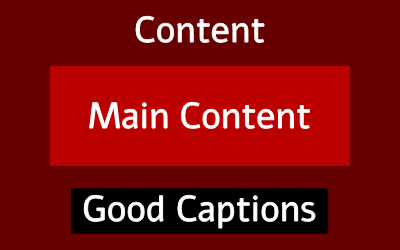Design Template by Anonymous
Web Accessibility for the Auditorily Impaired
Overview of the Issue
There are an estimated 466 million worldwide who are classified as auditorily impaired. This classification includes various levels of hearing loss ranging from mild to significant. Since the web is commonly thought of as a largely visual experience, one may underestimate the difficulties that the auditorily impaired deal with when using it. However, with an increase in video-based web content like instructive tutorials, entertainment, live streams, etc. those with hearing loss are excluded from fully engaging with this content.
Transcripts and Captioning for Video and Audio-Based Content
For the auditorily impaired, when interacting with video-based content, textual alternatives need to be used to fully digest the auditory aspect of the medium. Captions, although similar to subtitles, also include relevant descriptions of the audio that is captured, including tone, background sounds, music, etc. Fortunately, there are numerous technologies on the market that can automatically generate captions of videos, although these should be heavily reviewed to ensure accuracy. In actuality, manual captions are the ideal form of captions as they ensure utmost accuracy for auditorily impaired users. Another thing that can be provided in addition to captioning is text-based summaries of the auditory content to grant auditorily impaired users even greater understanding.
Tips on Creating Good Captions
There are many guidelines that can be followed to create captions that are easily usable to the impaired. For starters, captions should be easily readable, following the standard contrast ratio of 4.5:1 outlined by the WCAG and having ample text size. Additionally, there should be an effort to ensure that captions do not obscure or cover any important visual information that may be in the video. In some cases text simplification should also be considered. This is where the audio in the content is simplified and brought to basic terms, which can be helpful due to the high rates of language deprivation in the deaf and hard-of-hearing community. This largely stems from the fact that English is a second language for many deaf people, who mainly use sign language, and auditorily impaired people are often unfortunately given a lack of consistent access to natural language in its full form.

Clear and Slow Speech with Minimal Background Noise
Video and auditory content found on a site should have its focus set on clarity and appropriate pacing. This works in an effort to enable time for understanding and processing of the information presented for the auditorily impaired, as well as allow time for captioning and potential sign language to display. Additionally, this can also be immensely important for the success of speech-to-text tools that automatically convert audio into transcripts used for those with hearing-related disabilities. Additionally, background noise can be a huge distraction to the auditorily impaired, with the WCAG suggesting that background sounds are at the very least 20 dB lower than the main content.
Multiple Points of Contact
Websites often have sections that indicate all of the contact information for the site’s owners. It is very important to have a multitude of options available for a wide variety of ability sets. For example, having just a phone number displayed on a site can be detrimental to the auditorily impaired community, who typically need text-based communication systems like email.
Potential Sign Language Translations
Sign language that is displayed with video content can be an immensely helpful resource to those that have extreme hearing loss. For these people, sign language is often their main form of communication in their lives, and not having it on a site can be detrimental to their understanding of that site’s message. A common practice is to incorporate sign language into videos by placing a real-time translation in the bottom right corner. Remember though, it is important to make sure no critical visual content is covered up by this real-time sign language translation to make sure no information is lost.
